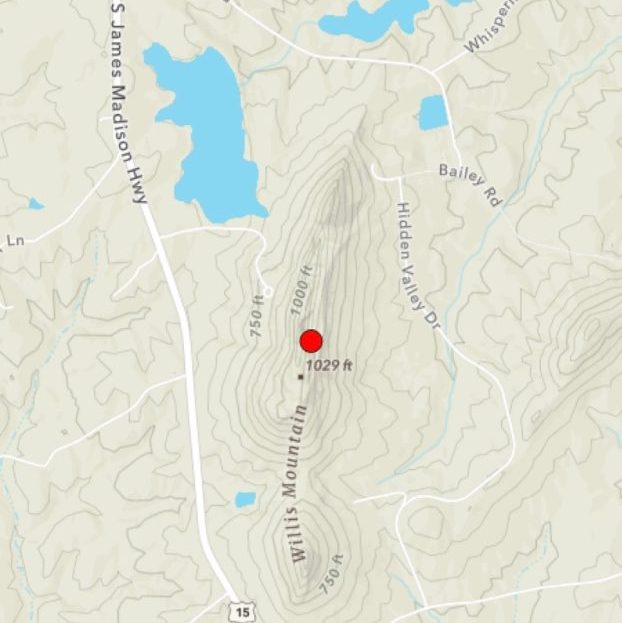What triggered the Buckingham earthquake on Tuesday?
Published 12:58 am Wednesday, May 7, 2025
|
Getting your Trinity Audio player ready...
|
The rattling and shaking started at 1:08 p.m. Tuesday and was strong enough that several geology students messaged their professor at Longwood University, asking what was going on. Folks as far east as Richmond and as far south as Keysville reported seeing parts of their homes shake. In the end, the U.S. Geological Survey confirmed that we did in fact have an earthquake hit the area. Originally coming in at 2.76 on the Richter scale, it was later upgraded to a 3.0, one with an epicenter just south of Dillwyn, near Willis Mountain. However, the somewhat shallow Buckingham earthquake, which originated just 5 miles below the surface, left several questions behind.
First, what caused the incident and second, if it’s likely we’ll experience some aftershocks over the next few days.
So we’ll answer the second one first. Yes, geological officials say, it is possible we’ll experience some more rumbling and shaking before the week is over. An aftershock is a smaller earthquake that follows the larger one in a series, often between one and three. According to officials from the U.S. Geological Survey, who directed The Herald to their website, this is part of the readjustment process, with the Earth’s crust settling after the first incident. They also say deeper earthquakes, those more than 30 kilometers underground, are much less likely to be followed by aftershocks than shallow ones. This time, the Buckingham earthquake was roughly 7 kilometers or 5 miles deep, which means more potential for aftershocks, but a smaller version.
Trending
“It’s definitely reasonable that we might potentially have aftershocks, but they would likely be small,” said Dr. Ravi Sankar. He works as Assistant Professor of Environmental Science and Geology at Longwood University. When the first rumble hit, Sankar was administering an exam, which made it a good time for an in-class experience.
What triggered the Buckingham earthquake?
While it has happened from time to time, earthquakes here in Central Virginia aren’t exactly common. So what triggered this one? One thing both Dr. Sankar and the U.S. Geological Survey officials agree on is they don’t know for certain.
In the immediate aftermath of Tuesday’s Buckingham earthquake, people were quick to point to the Kyanite mine, which is near Willis Mountain in Buckingham. However, both law enforcement and emergency officials confirmed there have been no emergency alerts coming from the mine or any other issues on Tuesday. Also, it was pointed out that Kyanite mostly deals with open pit mining, rather than anything as deep as the epicenter, five miles down. The Herald was unable to reach anyone with Kyanite on Tuesday or Wednesday morning.
“It’s definitely a lot of unknowns at this point,” Sankar said, about what caused the earthquake. “The truth is we don’t know.”
There are two main options, he said, as far as what triggered it. Option one is what’s called ‘induced seismicity’. Like the title suggests, that stems from human activity. Things like geothermal energy exploration, hydraulic fracturing or ‘fracking’ or underground testing can trigger an incident.
“You have changes that take place in the subsurface, because of stress conditions,” Sankar said. “So anything that can change the core pressure of the subsurface is something that can influence the stability of a fault and that can lead to an earthquake.”
Trending
However, none of those things are currently either scheduled or supposed to be taking place in the area, with any company. And so that leaves Option Number Two.
What about a natural cause?
“From a geologist’s perspective, the critical thing is the depth,” Sankar said. “An earthquake depth of 8 km (kilometers) means the earthquake’s focus, also called the hypocenter, which is the point inside the Earth where the rupture or release of energy occurs, is located just 8 kilometers below the Earth’s surface. This is extremely shallow for an earthquake and generally, shallow earthquakes tend to cause more intense shaking at the surface because they are closer to people, buildings and infrastructure.”
So that’s why things rattled around, being reported even as far south as Keysville down in Charlotte County. But if we’re looking at a natural cause, what would that be? The answer, Sankar said, could involve the mountains.
“The Blue Ridge Mountains, which is the range closest to Dillwyn, is part of the larger Appalachian Mountain system,” Sankar said. “The Blue Ridge Mountains and surrounding areas fall within the Central Virginia Seismic Zone, which experiences occasional seismic activity, natural as opposed to human-induced. This area is pretty much geologically stable, but it is still possible for earthquakes to occur. When these happen, these are known as intraplate earthquakes. Most earthquakes here are small and often not felt, but of course like today, it can be felt.”
Making room for some superstition
Tuesday’s rumble caused several people to reach out to The Herald and share their stories. Some were driving and initially blamed their car. Others were at home and watched as cabinets rattled and things moved around.
We also had several Longwood athletics fans and alumni who reached out and brought a smile during the whole thing, as they pointed out this is technically the third earthquake felt in the Farmville area over the last 20 years and that is accurate. The first was in 2003, coincidentally, they pointed out, when Longwood started reclassifying to Division 1. The second was in 2011, just before Longwood was invited to join the Big South Conference. And now here we are in 2025. So based on that, you have some Lancer fans wondering if that means a big year on the horizon in athletics.






